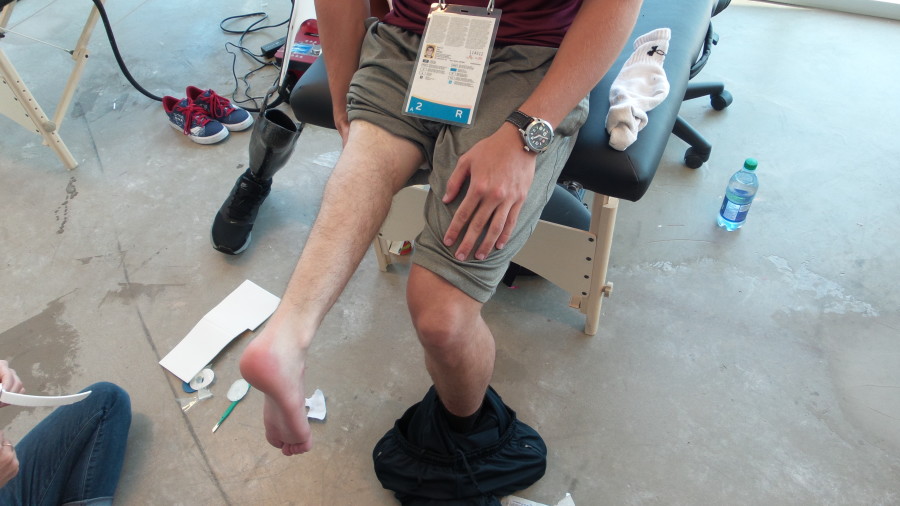Hey all, Dr. Jeff Anthony here in Toronto at the 2015 Parapan Am games. The Parapan Am games are held every four years following the Pan American Games. The Pan American and Parapan Am Games are the world’s third largest international multi-sport Games; they are only surpassed in size and scope by the Olympic Games and the Asian Games.

First, a little background iToronto_2015_has_released_its_second-quarter_financials_Toronto_2015nformation: The first Pan American Games were held in Buenos Aires, Argentina, in 1951 with the inaugural Parapan American Games being held in Mexico City in 1999. Both the Pan Am and Parapan Am Games are held every four years for the athletes of the 41 PASO member nations, in the year preceding the Olympic and Paralympic Summer Games. While the Pan Am and Parapan Am Games have been hosted in a dozen countries throughout the Americas, Canada has had the honor of hosting them twice; in 1967 and 1999, both of which were in Winnipeg, Manitoba.
While the Parapan Am Games hosts nearly identical games to that of the Pan Am Games, it differs in that its competitors are categorized based on their particular disability. The categories are:
Amputees
Cerebral Palsy: Athletes with non-progressive brain damage, for example cerebral palsy, traumatic brain injury, stroke or similar disabilities affecting muscle control, balance or coordination.
Intellectual Disability: Athletes with a significant impairment in intellectual functioning and associated limitations in adaptive behavior.
Wheelchair: Athletes with spinal cord injuries and other disabilities that require them to compete in a wheelchair.
Visually Impaired:Athletes who are either partially or fully blind
Les Autres: Athletes with a physical disability that does not fall strictly under one of the other five categories, such as dwarfism, multiple sclerosis or congenital deformities of the limbs such as that caused by thalidomide.
Wheelchair Basketball is a game that consists of bumping, sprinting and impressive maneuvering. The US men’s team has a good chance of winning gold at the Parapan Am games and are already qualified for the 2016 Olympics in Rio.
The rules are similar to able bodied basketball in that the basket is the same height, the same ball is used and the court is the same size. It differs in other areas, such as traveling. Traveling for example is when they touch their wheels to move more than twice without dribbling. Play is intense as players set picks, steal the ball and on occasion, box a player out and keep them from play. The Parapan Am Committees rate the players according to their disability 1.0 – 4.5, with 1 being the most severe disability like paraplegia at mid chest so they can’t move their legs and have poor core strength. The total sum of the scores of the 5 players in play cannot exceed 14.

USA Men’s Wheelchair Basketball

Men’s Wheelchair Rugby
Some of the games that take place during the Parapan Am are created during the games themselves by devoted athletes with passions for competing that can’t be found else where. For example, in 1977 during the Canadian games, a quadriplegic was upset that he couldn’t play basketball, and so helped to develop wheelchair rugby. Instead of a traditional rugby ball, a volleyball is used in its place. During each game it is a whirlwind of excitement as each team tries to score against one another.
Steve is a 17 year old high jumper whom had a rotationplasty at 13. He had a cancer of the distal femur; his surgeon removed his knee, rotated the foot/ankle and reattached to the proximal femur. They have to rotate the distal part so that he has a functional knee. He can walk, jump, skip, etc. What’s interesting is when he places his rotated foot into a prosthesis, the ankle works as a reverse knee.

Rotationplasty

USA Men’s Sitting Volleyball
Sitting volleyball is for amputees, or individuals with problems with their lower extremities. The court is smaller and the net is closer to the ground. The players need to always have their buttock on the ground, and they can block the serve, otherwise the rules are similar to able bodied volleyball. Brazil is currently the best in the world, but US and Canada are also in the running.

USA Men’s Sitting Volleyball captured the Silver Medal!

Goal ball was initially started after WWII to help blind veterans get back into activity. There are 3 visually impaired people on a team (if not completely blind, eyes are taped), using black eye patches. Court size about 60 ft x 30 ft. The ball has small bells inside to make a noise. The goal is to roll that ball to the opposing net. The defense lays down to block the ball (hopefully not bumping each other). The arena is totally quiet during play so the athletes can hear where the ball is, lay down to block it, then stand and throw it back. Left are our American players (the ball hit the first player and is seen in the air), against the Brazilians (not pictured) who have dominated this sport.
Blind Soccer, or 5 man football, is really crazy. The goal keeper is sighted, the other 4 are visually impaired and blind folded. The ball has small bells to hear. The goal keeper, and their guide (behind the opponents net) are yelling directions as their ‘eyes’.
In track you have blind runners of all distances with running guides who are usually tethered to the athlete, and have to keep pace as they’re talking directions. (We took gold in the 100 meter men’s T1 run). Also blind long jumpers who listen for their guide to clap as to where to jump. This is very dangerous as we had one athlete at the Chula Vista Olympic Training Center, miss and ended up fracturing both legs after hitting the side of the pit.
Blind swimmers stay close to the lane lines, then flip turn when poked on the back with a long pole and ball at the end of the pool.
Finally and definitely not least is visually impaired Judo. We took the Silver in one wt class, bronze in another. Otherwise didn’t do as well as we’d like. The goal is to have an effective throw, followed by either pinning them (need to hold for 25 seconds), or grappling them into submission. Matches lasted 5 minutes (4 for women). I remember competing in college, and our sensei would have us close our eyes so that we could ‘feel’ the opponent; but when you got into trouble you’d open your eyes!
Overall I had an amazing experience at this years’ Parapan Am Games. The moments I was able to share with the athletes on and off the field are ones that I will never forget and will take with me for a life time. Now its back to training however for all these athletes in preparation for the 2019 Parapan Am Games where we plan to take back defeat from Brazil in Peru.
For more information on the Parapan Am Games check out: https://www.toronto2015.org/

